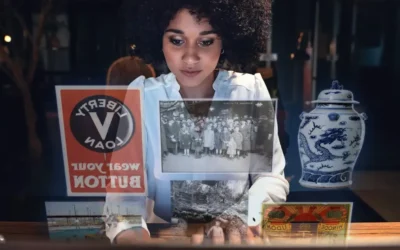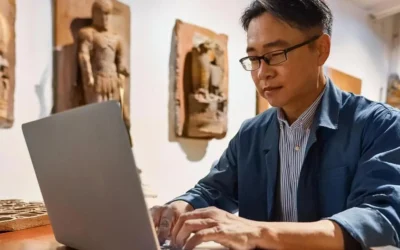TrendsWatch 2021: COVID on Campus

Rachael Cristine Woody
Every year the American Alliance of Museums (AAM) Center for the Future of Museums releases a TrendsWatch report. For the past two years I’ve written a response piece to each topic tackled within the reports. Continuing that strategy, this post addresses AAM’s fourth topic for 2021.
For an introduction to the TrendsWatch reports and the following miniseries, please see: TrendsWatch 2021: Navigating a Disrupted Future. The previous posts in this series are TrendsWatch 2021: Closing the Gap, TrendsWatch2021: Digital Awakening, and TrendsWatch 2021: Who Gets Left Behind.
The TrendsWatch 2021 report continues with the fourth of five topics: COVID On Campus: How the pandemic is reshaping higher education. We first spoke about wealth inequality in a previous post: Closing the Gap. This post will focus on how the pandemic has hit colleges and universities, museums within an academic system, students, and the towns they call home. In the past decade enrollment has declined (10%), tuition has been raised, and student debt has soared. Additionally, tenure track jobs have been shrinking while the reliance on adjunct faculty and graduate students has increased.
Challenges
Colleges and Universities: Colleges and universities of all shapes and sizes were struggling financially long before COVID-19. However, as with all things, COVID has accelerated the decline by devastating enrollment income and costing schools more money as they shift to online learning, create socially distant setups, and incorporate COVID in-person protocols. Additionally, many students have chosen to pause or defer college enrollment, have opted for online degrees, or aren’t willing to pay in-school prices if they can’t benefit from the full college experience. Finally, foreign enrollment was already in decline due to US immigration policies and a hostile environment. International students will be further discouraged to attend US colleges due to pandemic travel restrictions and risks.
School-based Museums: Then there are the 2700 museums housed within a college or university structure. These museums support students in recreational and scholarly activities, and yet many aren’t viewed as essential to school business. These museums may face long-term or even permanent closures and the risk that their collections will be taken and sold to keep the school financially afloat.
Students: Currently enrolled students are attempting to attend classes and get a degree during an incredible arduous time. In-person learning was abruptly shifted to online with little to no controls in order to provide equitable learning tools and environment. Those who are still attending are receiving a quality of education they didn’t sign up for and any resources and hands-on learning opportunities have been severely limited. And on top of it all, tuition is still incredibly expensive. Very few schools have adjusted tuition costs because they literally can’t afford to. With this expensive and likely subpar school experience, it’s not hard to see why many students are deferring or opting for entirely online degrees.
Towns: Finally, there are the towns that thrive due to their close proximity to the school. With every year of enrollment, the school creates and supports a commercial ecosystem. We’re not just facing potential school and museum closures; we’re looking at the possibility of losing entire towns.
Recommendations
Elizabeth Merritt, Founding Director of the Center for the Future of Museums has the following recommendations to help elevate school museum visibility by making themselves indispensable while simultaneously trying to keep students, schools, and towns from disappearing.
- Explore how museums can add value to the student experience.
- Support students, researchers, and instructors through easy-access online resources and programming.
- Partner with the library to share and boost resource access.
- Creatively partner with local business and help to mitigate their loss.
- Provide meaningful work and learning experiences for students and local community members.
- Offer virtual internships or other credentialing to students and the local community.
Conclusion
While school-situated museums may be a small percentage of total museums, it’s clear that the ecosystem they support is much larger. There are broad and significant implications if one or all of them fail financially—essentially causing a domino effect. While it can be overwhelming to think that we need to save three very different entities, at least we know we’re not alone in this crisis. The underpinning problems may be very different, but the solutions (and positive after- effects) are likely to be multipurpose in application. As President John F. Kennedy said, “A rising tide lifts all boats.” Stay tuned next week for the final post in our series: TrendsWatch 2021: Strategic Foresight.

Rachael Cristine Woody
Expert, consultant and blogger Rachael Cristine Woody advises on museum strategies, collections management, digital museums, and grant writing for a wide variety of clients. She is a popular presenter and Lucidea Press author. For more on museum success, learn about Lucidea’s Argus Museum CMS for virtual, multimedia presentation of collections, visitor engagement, and museum staff productivity and impact
Similar Posts
How Archives Can Enrich Museum Collections Online
Staffed archives are in constant motion in their attempt to provide and broaden access to the archival collections.
How to Enhance Museum Collections Online with New Information
One of the wonderful things about museums is that the learning never stops. There are always projects, exhibits, and programs in development that serve as constant instigators of research.
How to Enhance the Museum Object Record with Immediately Available Information
This month’s series focuses on the enhancement of museum object data using “hidden” troves of information. Hidden is in quotes because the information exists and often is not hidden—it just hasn’t been gathered for inclusion in the museum Collections Management System (CMS).
Where the Gaps Live with Traditional Museum Object Cataloging
Standard museum cataloging leverages the usual set of fields that are considered best practice. We tend to refer to this information as “the tombstone information,” meaning it is clear and concise in communicating the “need to know” information.




Leave a Comment
Comments are reviewed and must adhere to our comments policy.
0 Comments